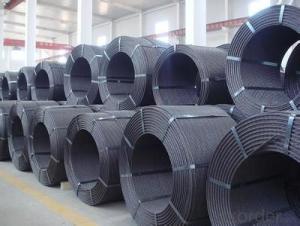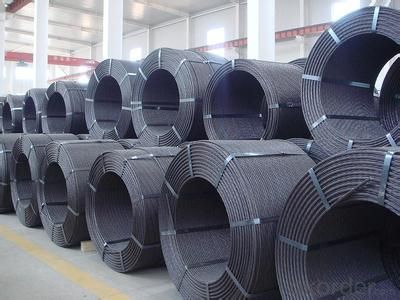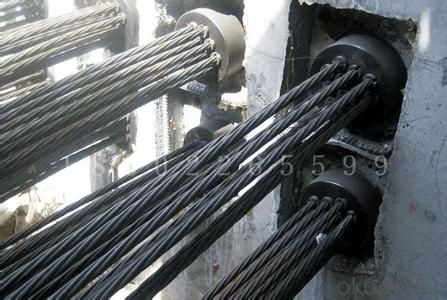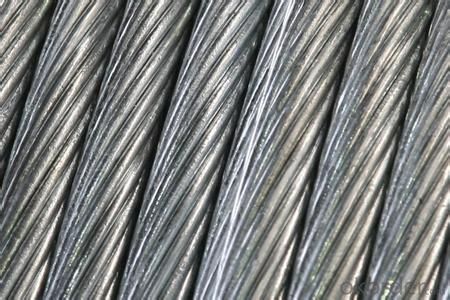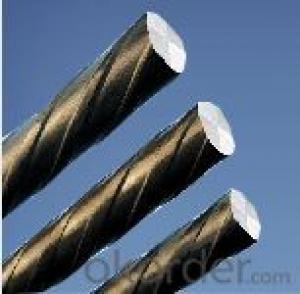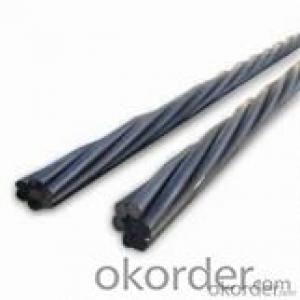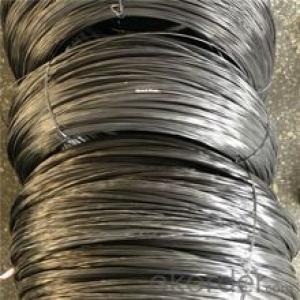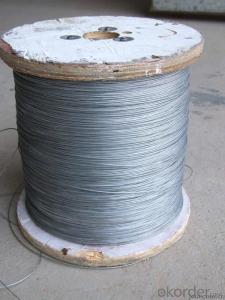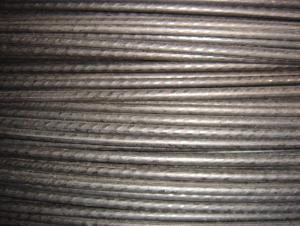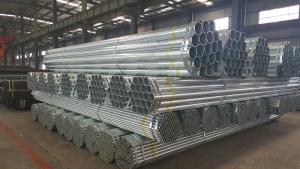High Tensile Steel Wire with Spiral Ribs
- Loading Port:
- China main port
- Payment Terms:
- TT or LC
- Min Order Qty:
- 20 m.t.
- Supply Capability:
- 3000 m.t./month
OKorder Service Pledge
OKorder Financial Service
You Might Also Like
1、Structure of High Tensile PC Steel Wire with Spiral Ribs Description:
Prestressed Concrete Steel Wire, also named PC steel wire orPC wire, is made from high carbon steel with low relaxation high tensile strength. PC wires are sorted into plain surface PC wire, spiral ribs PC wire and indented PC wire. They are commonly used for concrete structure reinforcement such as highway, high-speed railway projects, large-span bridges, overhead crane beam, coal mines.
2、Main Features of High Tensile PC Steel Wire with Spiral Ribs:
•Perfect cohesion. Spiral ribs and indented surface can strengthen the bond between wire and concrete, thus it improves the performance of the PC products and extends its life.
•Low relaxation high tensile strength. With low relaxation 2.5% and tensile strength up to 1860Mpa.
3、High Tensile PC Steel Wire with Spiral Ribs Images:
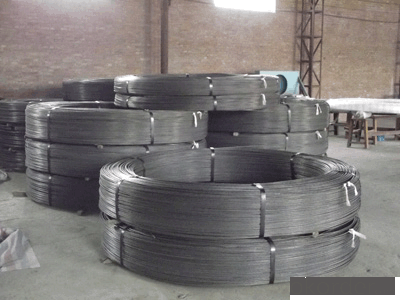
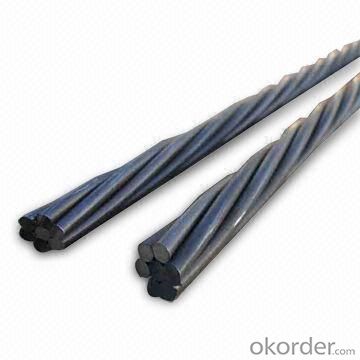
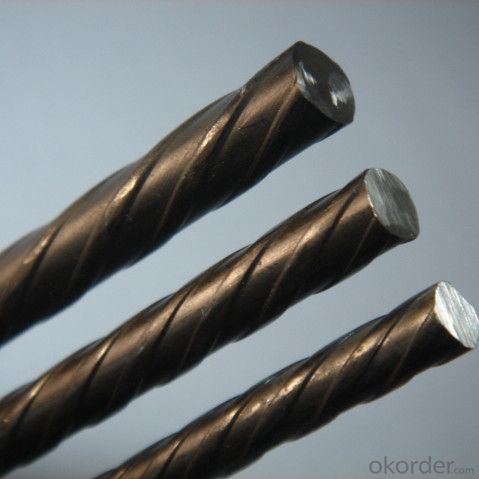
4、High Tensile PC Steel Wire with Spiral Ribs Specification:
Quick Details
Steel Grade: 77B or 82B high carbon wire rod
Standard: GB
Wire Gauge: 4.0mm to 10.0mm
Place of Origin: Tianjin, China (Mainland)
Type: PC
Application: Construction
Model Number: 4.0mm to 10.0mm
Packaging & Delivery
| Packaging Details: | Each coil is strapped by steel bands and fully wrapped in anti-rust paper & P.P woven sheet. |
|---|---|
| Delivery Detail: | within three week after confirm the order or contract. |
The character of the spiral ribs wire is there are 3-6 protruding ribs on the surface.
The new product was invented by Silvery Dragon in 1991, and the research program of the product includes spiral drawing die, spiral deforming technique etc. 12 proprietary technologies. The product is characteristic of 3 to 6 spiral ribs through spiral deforming drawing on the surface of wire, increasing the bond ability with concrete and raising PC products properties. Since 1997, spiral rib PC wire has already fully took place of indented PC wire, and it has been applied in PC telegraph pole, PC hollow floor plate, PC sleeper, high-speed railway PC sleeper plate, PC water supply pipe etc. Since 1996, it has already been exported to the overseas market. In 2006, the product passed the examination and certificate on the properties by German TU Munich; now the product is applied by Great Britain, Ireland, Bangladesh, German, Poland, etc. more than 30 countries. The production of the product is according to Chinese GB/T5223-2002. Except the shape, other standards for mechanical properties are interchangeable with those popular in the world, or we can use the reasonable standard after consulting with customers.
5、FAQ of High Tensile PC Steel Wire with Spiral Ribs:
①How is the quality of your products?
Our products are manufactured strictly according to national and internaional standard, and we take a test on every pipe before delivered out. If you want see our quality certifications and all kinds of testing report, please just ask us for it.
Guaranteed: If products’ quality don’t accord to discription as we give or the promise before you place order, we promise 100% refund.
②How about price?
Yes, we are factory and be able to give you lowest price below market one, and we have a policy that “ for saving time and absolutely honest business attitude, we quote as lowest as possible for any customer, and discount can be given according to quantity”,if you like bargain and factory price is not low enough as you think, just don’t waste your time.Please trust the quotation we would give you, it is professional one.
③Why should you chose us?
Chose happens because of quality, then price, We can give you both.Additionally, we can also offer professional products inquiry, products knowledge train(for agents), smooth goods delivery, exellent customer solution proposals.Our service formula: good quality+good price+good service=customer’s trust
SGS test is available, customer inspection before shipping is welcome, third party inspection is no problem.
Any question, pls feel free to contact us !
- Q: What does seamless steel tube mean? What are the main uses? What are the classifications?
- 1.: Construction of the underground pipeline, levy more pumping, boiler hot water transportation etc..2., mechanical processing, bearing sets, processing machinery parts.
- Q: How does the price of steel pipes vary based on size and grade?
- The price of steel pipes tends to vary based on their size and grade. Generally, larger pipes and higher-grade steel tend to have higher prices due to the increased raw material and manufacturing costs involved. However, market demand and supply dynamics can also play a role in the price fluctuations.
- Q: Are steel pipes suitable for industrial cooling systems?
- Yes, steel pipes are suitable for industrial cooling systems. They are highly durable, resistant to corrosion, and can withstand high pressures and temperatures. Additionally, steel pipes have excellent heat transfer properties, making them efficient for cooling applications.
- Q: How are steel pipes used in the construction of railways?
- Steel pipes are used in the construction of railways for various purposes, including the installation of track support structures, drainage systems, and signaling equipment. They provide strength and durability, ensuring the stability and longevity of railway tracks, while also facilitating the efficient flow of water and the installation of crucial communication and signaling components.
- Q: What are the lengths of scaffold steel tubes?
- Scaffolding steel pipe standard length is 6 meters, for easy use, respectively, 6 meters, 3 meters, 2 meters, 1.5 meters, 1 meters, etc., if there is a special length, you need to intercept.
- Q: How are steel pipes used in the construction of stadiums and arenas?
- Steel pipes are commonly used in the construction of stadiums and arenas for various purposes such as structural support, plumbing, and HVAC systems. They provide a strong and durable framework for the building, allowing for large spans and open spaces. Additionally, steel pipes are used for the distribution of water, gas, and waste, as well as for ventilation and air conditioning systems. Overall, steel pipes play a crucial role in ensuring the safety, functionality, and longevity of stadiums and arenas.
- Q: DN150 welded steel tubes one meter multiple
- DN150 welded steel pipe according to the thickness of two specifications: outer diameter 165mm, wall thickness 4.5mm, 17.81Kg per meter weight, wall thickness of 5.5mm, 21.63Kg. per meter weight
- Q: What are the different international standards for steel pipes?
- The industry recognizes and utilizes multiple international standards for steel pipes. Some noteworthy standards are as follows: 1. ASTM A53: This standard encompasses black and galvanized steel pipes, both seamless and welded. It finds common application in low-pressure scenarios involving water, gas, and steam. 2. ASTM A106: This standard covers seamless carbon steel pipes designed for high-temperature usage. It sees widespread use in refineries, power plants, and petrochemical industries where elevated pressure and temperature conditions prevail. 3. ASTM A312: This standard pertains to austenitic stainless steel pipes that are seamless, welded, and heavily cold worked. It is frequently employed in industries such as chemical processing, food processing, and pharmaceuticals, where high temperatures and corrosive environments are encountered. 4. API 5L: This standard outlines the requirements for manufacturing seamless and welded steel pipes for use in pipeline transportation systems within the petroleum and natural gas industries. It specifies two product specification levels (PSL1 and PSL2). 5. EN 10216: This European standard addresses seamless steel pipes utilized for pressure purposes. It finds application in various industries, including power generation, chemical, and oil and gas. 6. JIS G3454: This Japanese standard focuses on carbon steel pipes used for pressure service, commonly employed in the transportation of water, gas, and oil. 7. DIN 2448: This German standard provides specifications for seamless steel pipes used for general purposes. It is extensively utilized across various industrial applications. These examples represent only a fraction of the numerous international standards governing steel pipes. Each standard delineates distinct requirements concerning manufacturing, dimensions, mechanical properties, and testing to ensure the pipes' quality and performance in specific applications. Manufacturers, suppliers, and users must comprehend and adhere to the relevant standards to guarantee the safe and reliable utilization of steel pipes.
- Q: What are the factors to consider when selecting a steel pipe for a specific application?
- When selecting a steel pipe for a specific application, there are several factors that need to be considered. These factors include the required strength and durability, the intended use and environment, the size and dimensions needed, the corrosion resistance properties required, the temperature and pressure conditions, and the budget available for the project. By taking all these factors into account, one can choose the most suitable steel pipe that meets the specific requirements of the application.
- Q: Can steel pipes be used for structural purposes?
- Yes, steel pipes can be used for structural purposes. Due to their high strength, durability, and resistance to various environmental factors, steel pipes are commonly used in construction for applications such as supporting structures, frames, and columns. They offer superior load-bearing capacity and are especially suitable for use in large-scale infrastructure projects.
Send your message to us
High Tensile Steel Wire with Spiral Ribs
- Loading Port:
- China main port
- Payment Terms:
- TT or LC
- Min Order Qty:
- 20 m.t.
- Supply Capability:
- 3000 m.t./month
OKorder Service Pledge
OKorder Financial Service
Similar products
Hot products
Hot Searches
Related keywords
